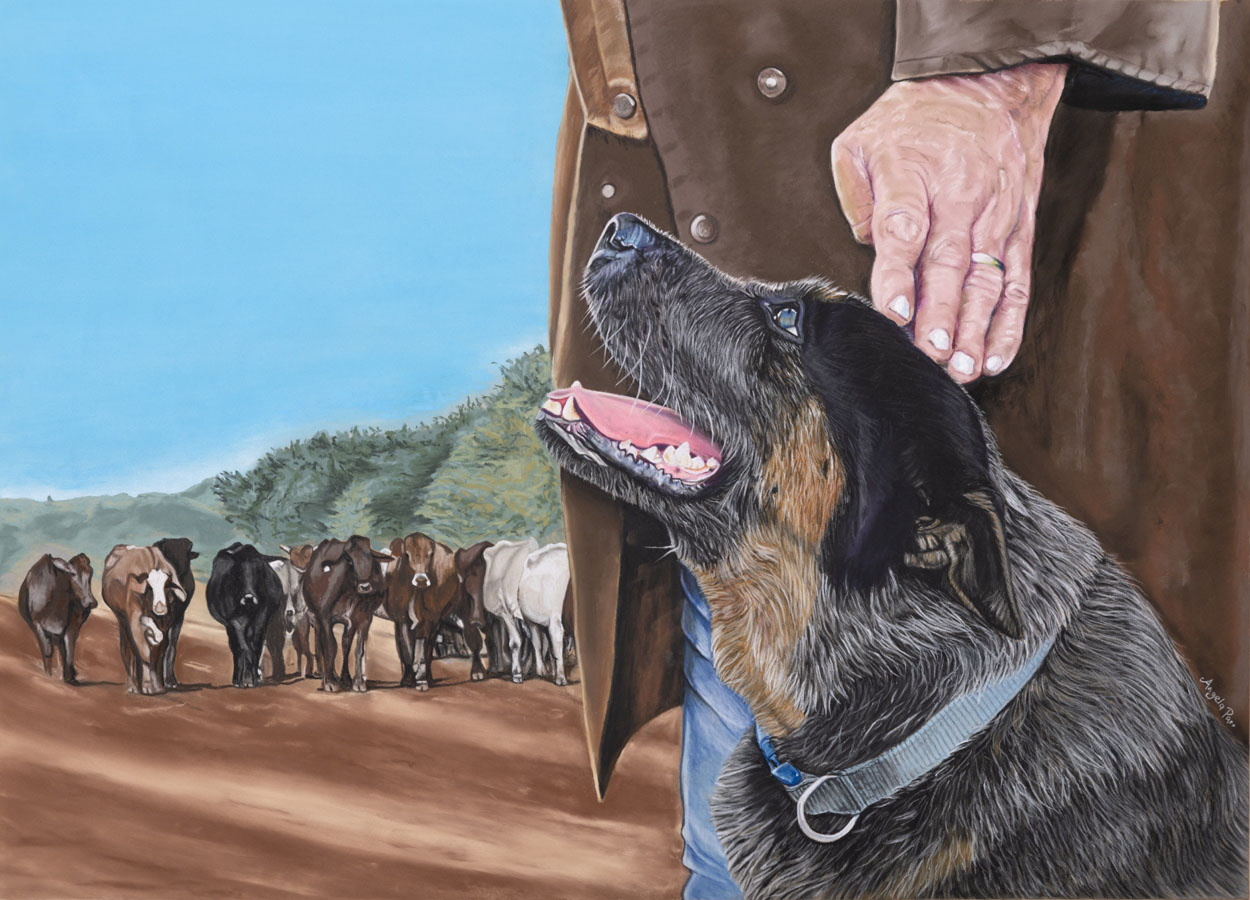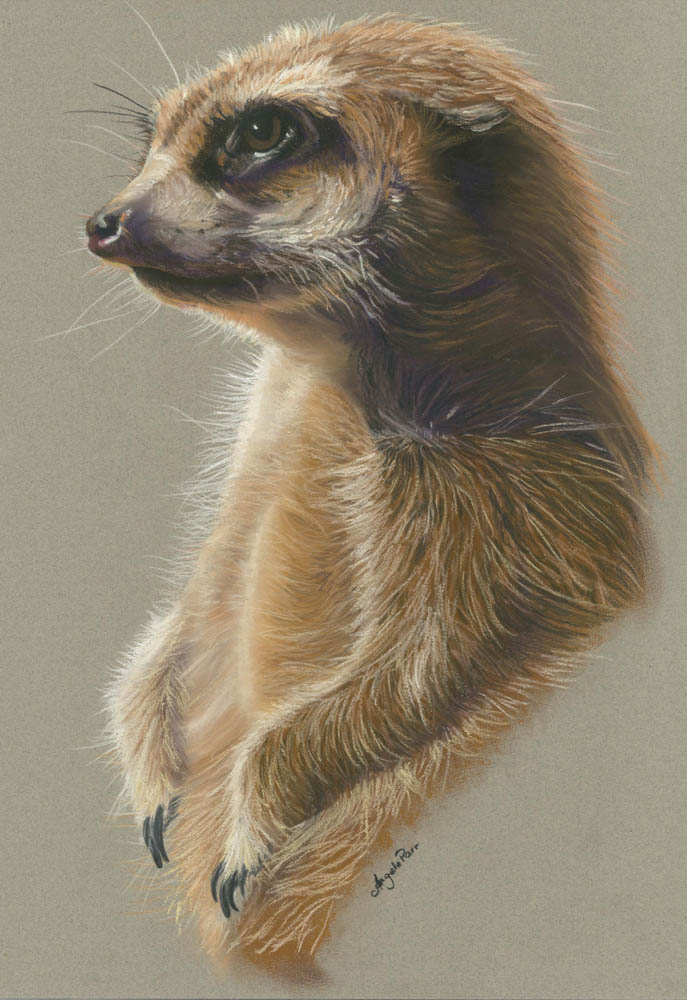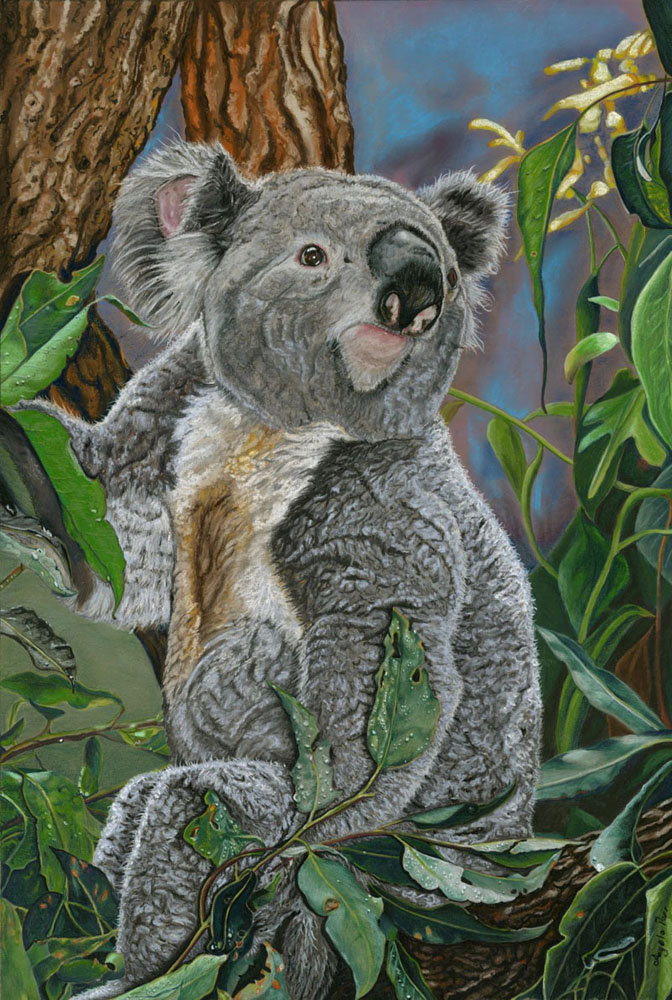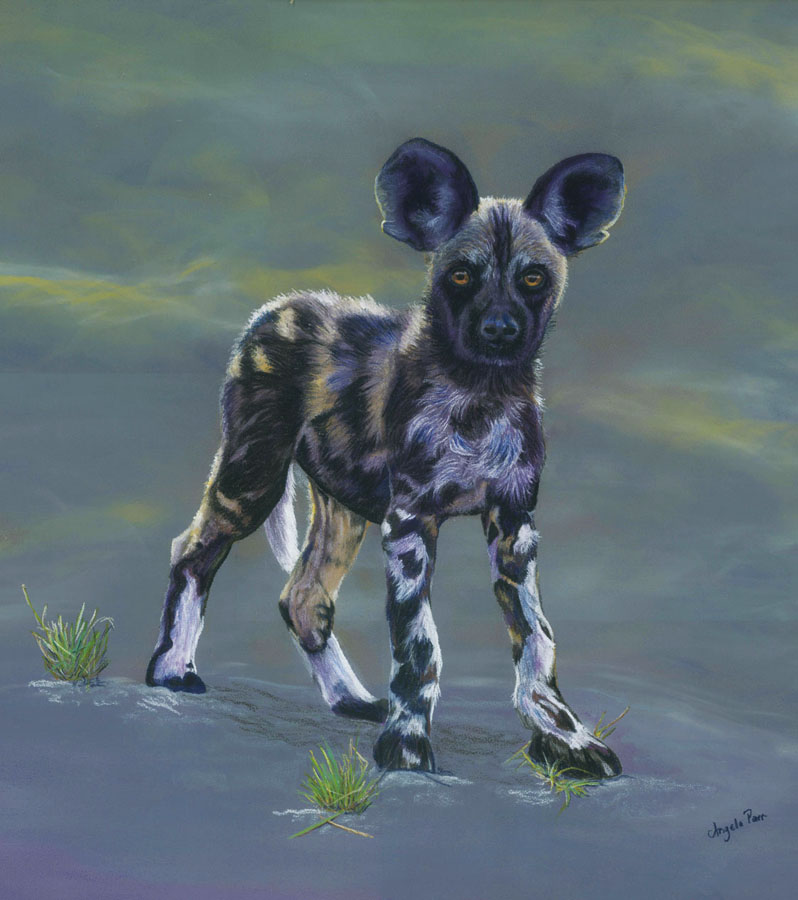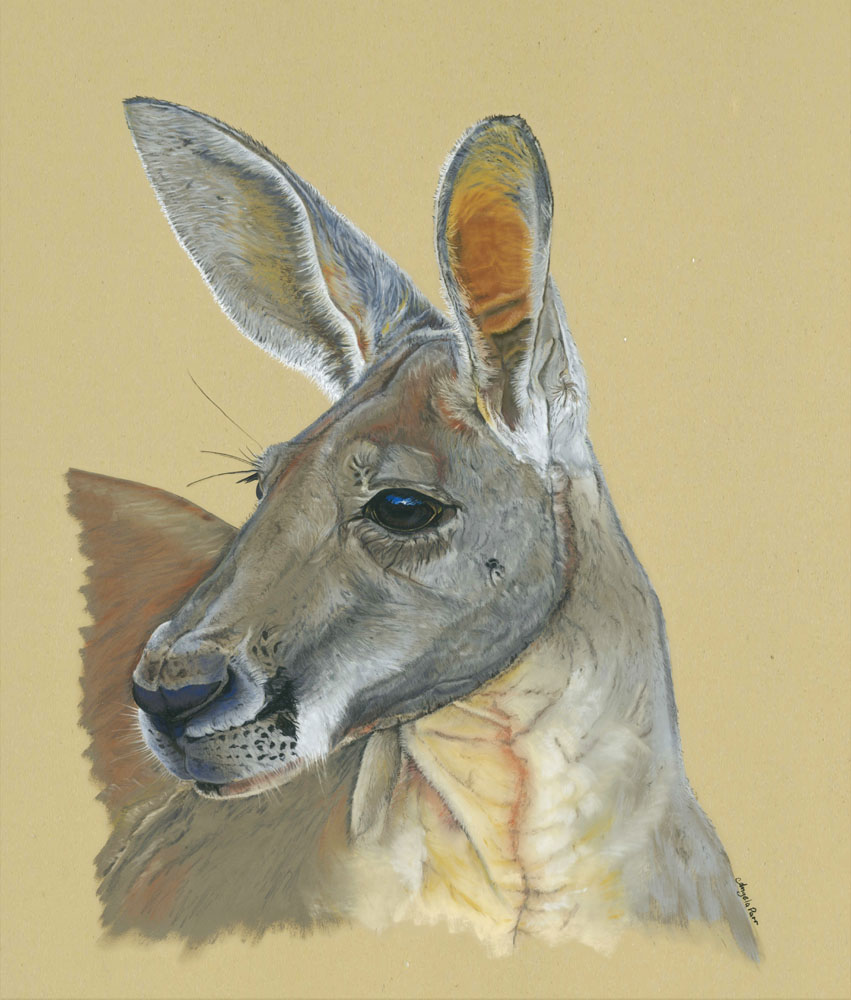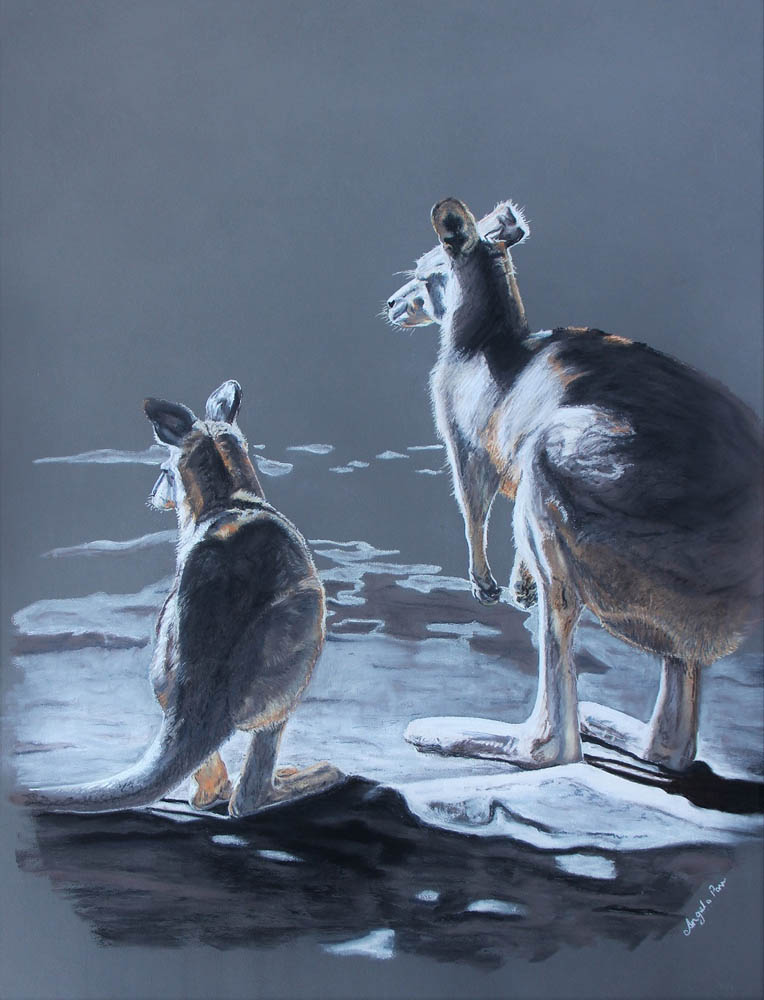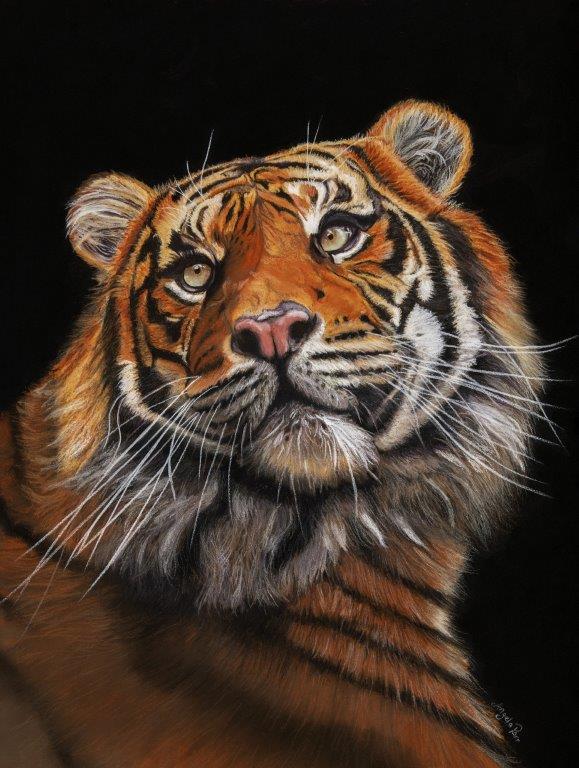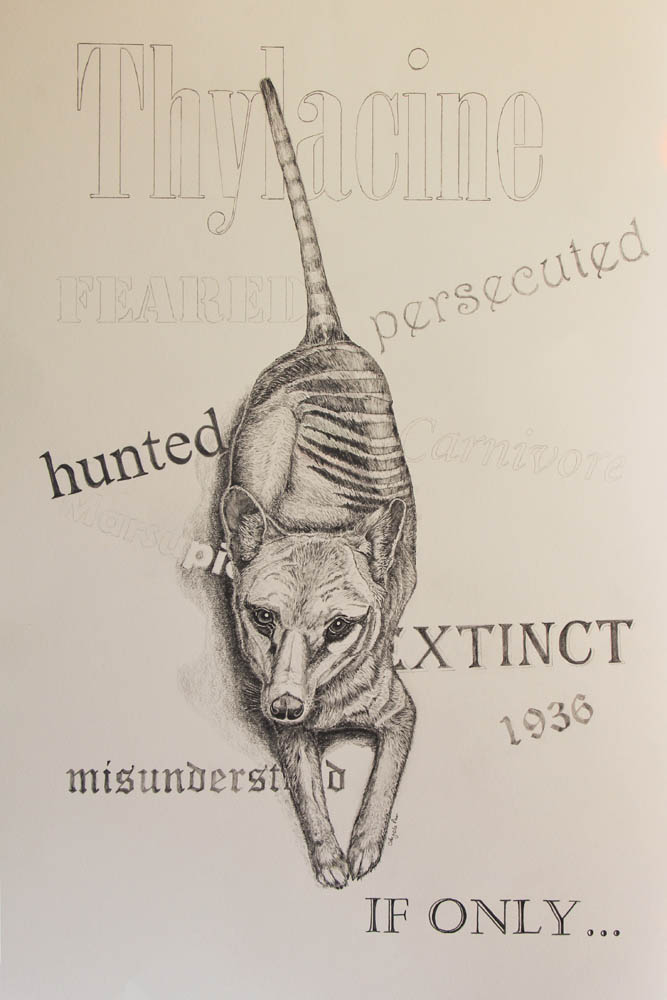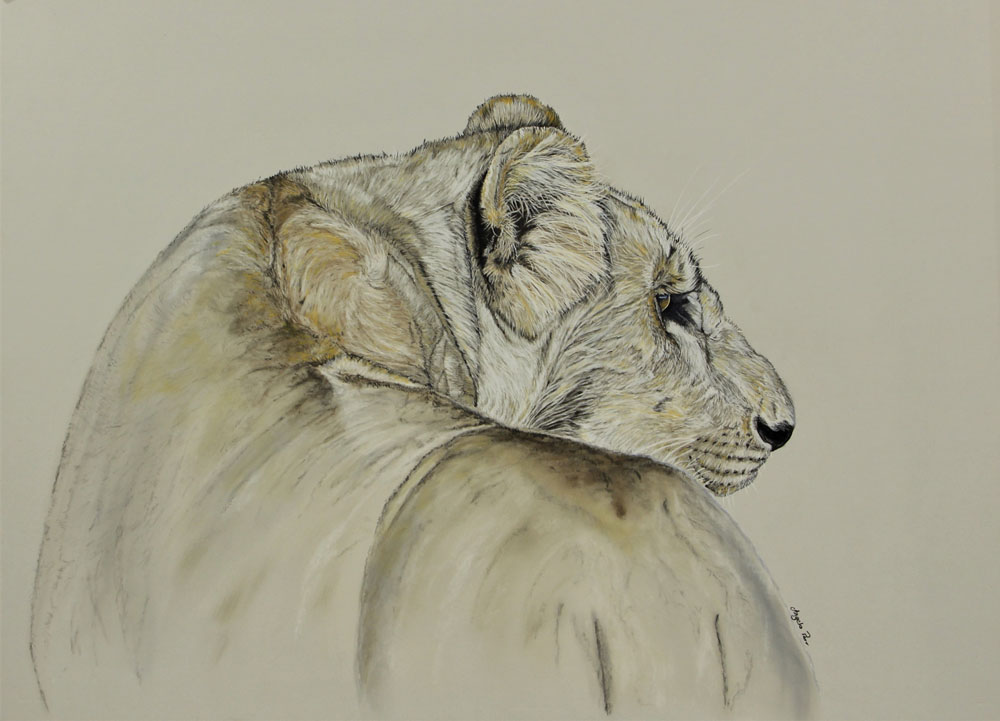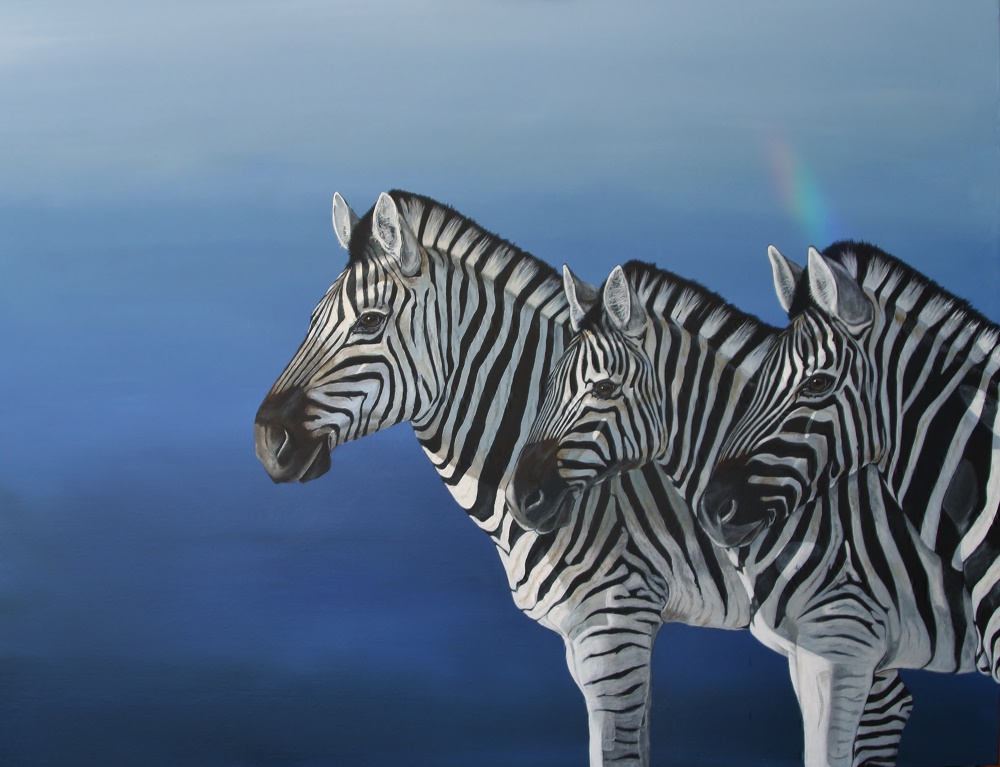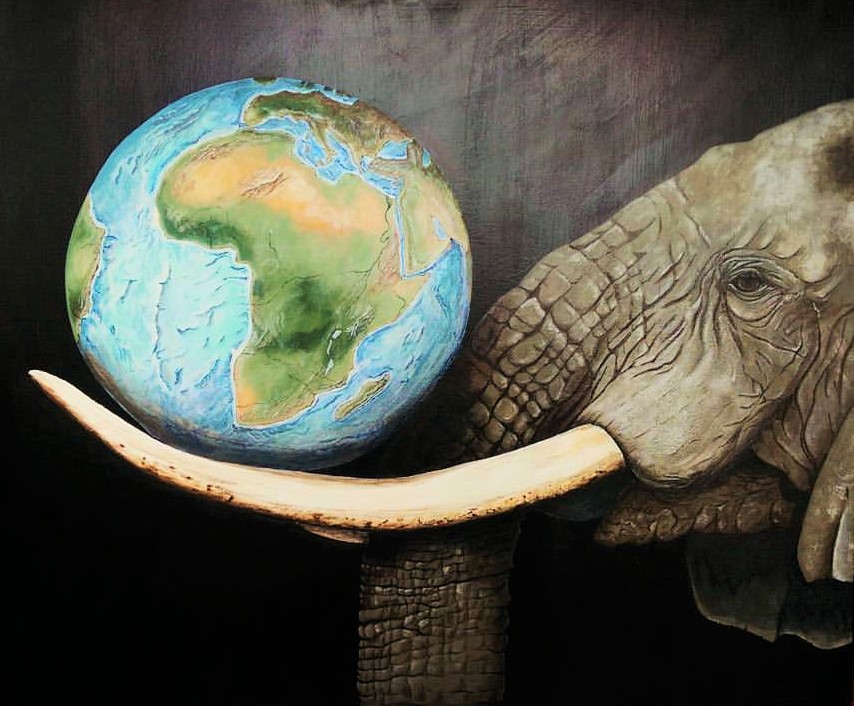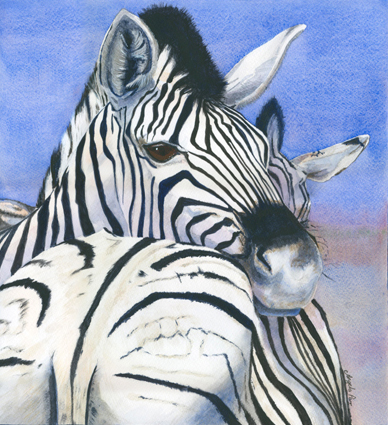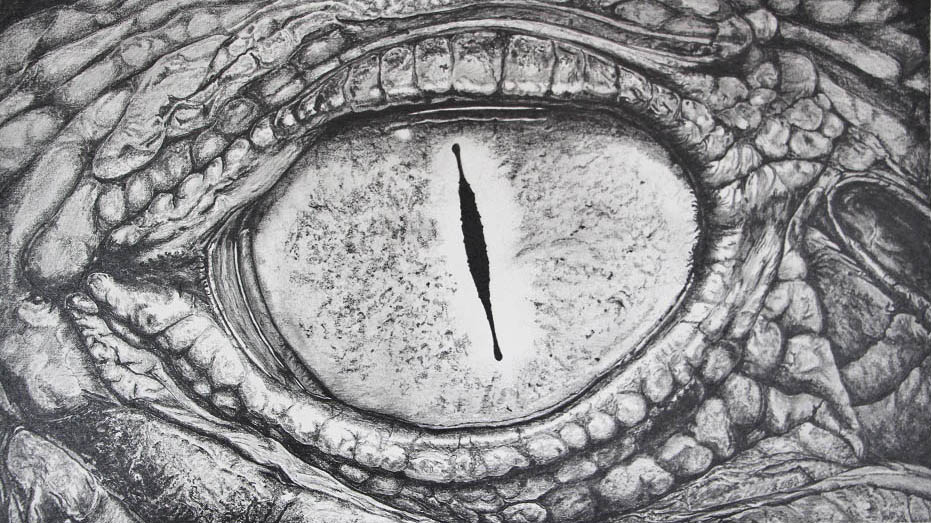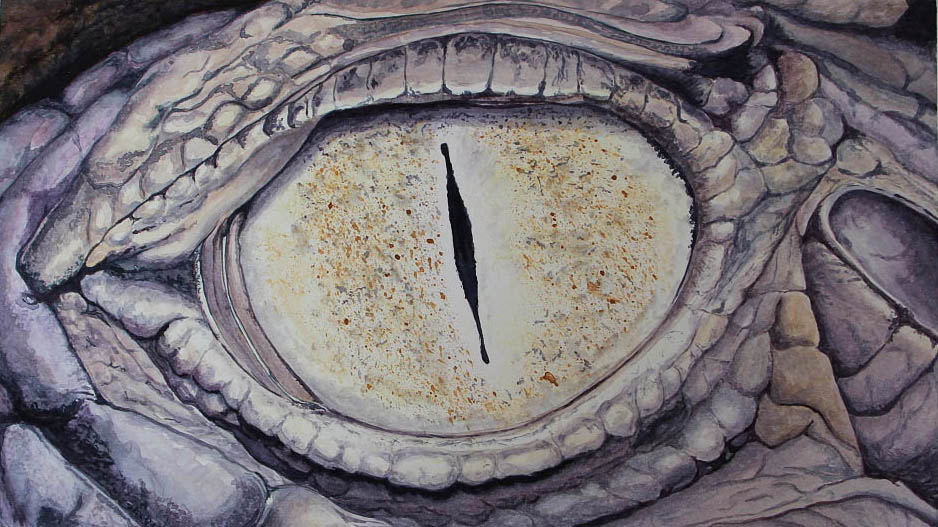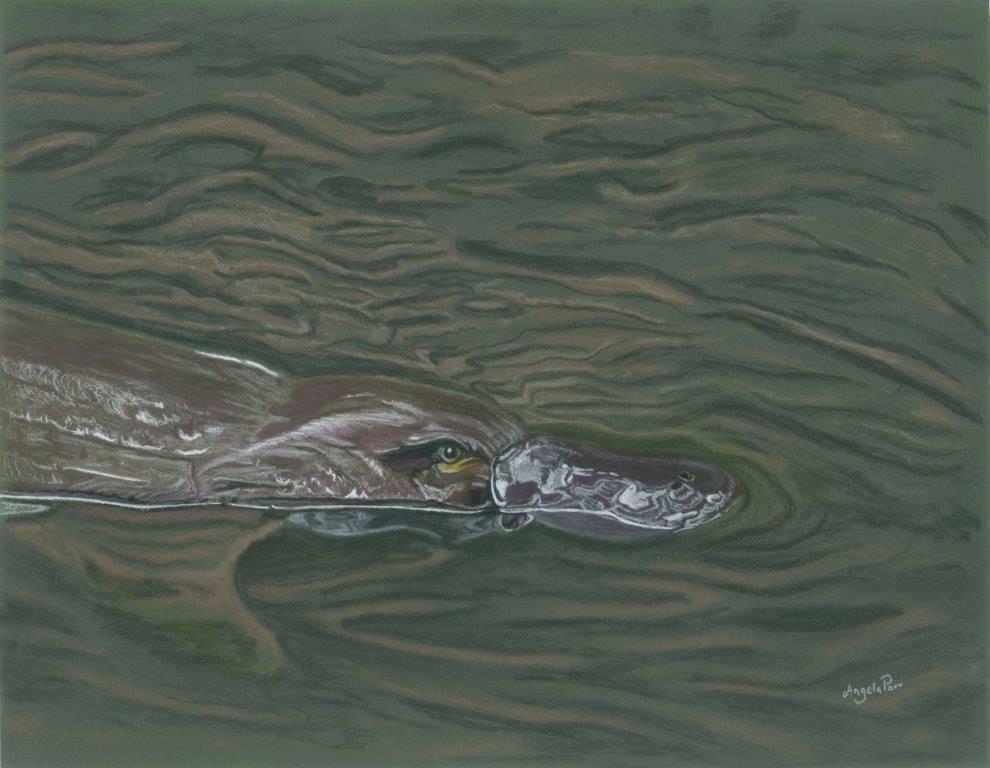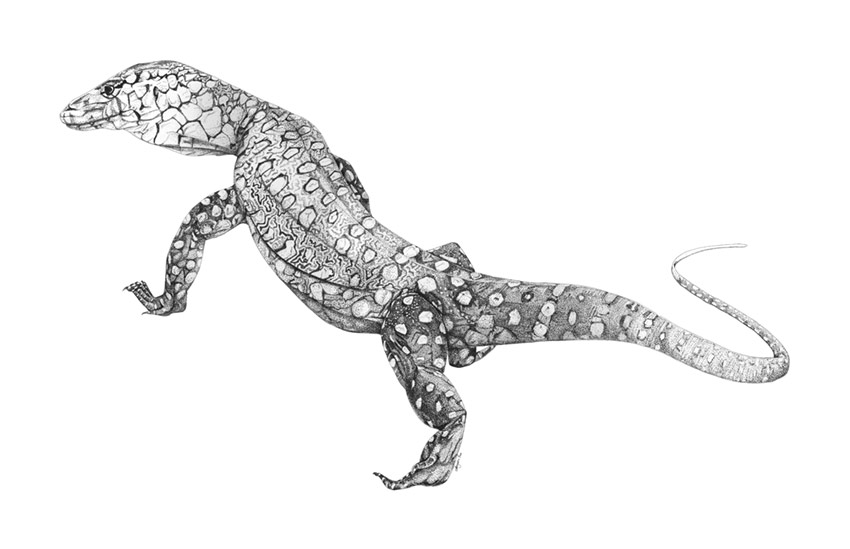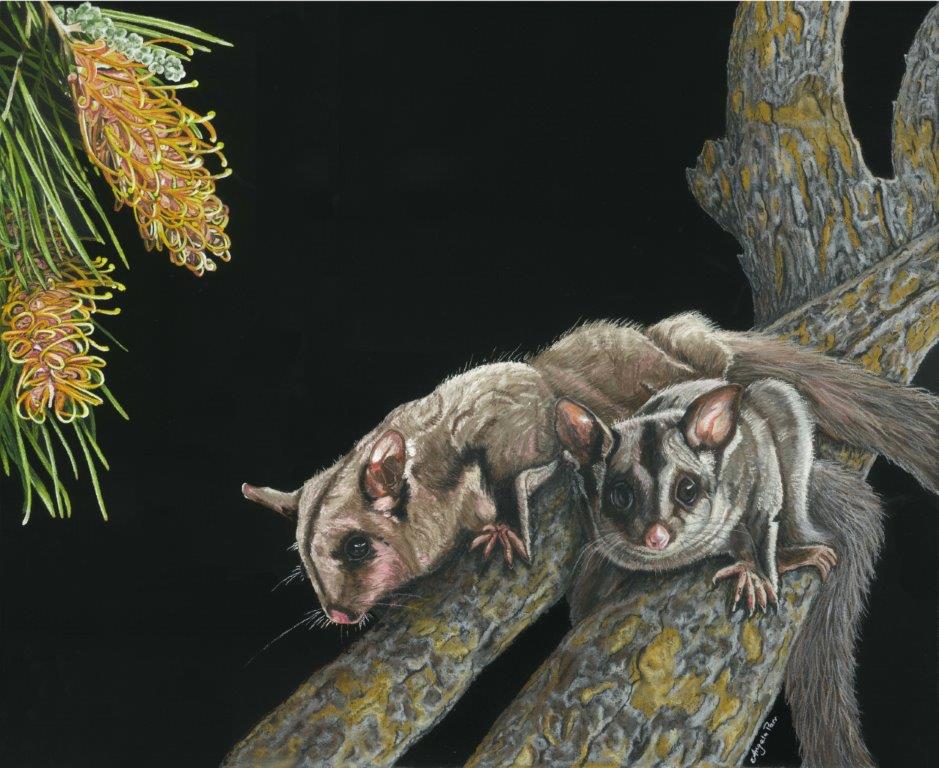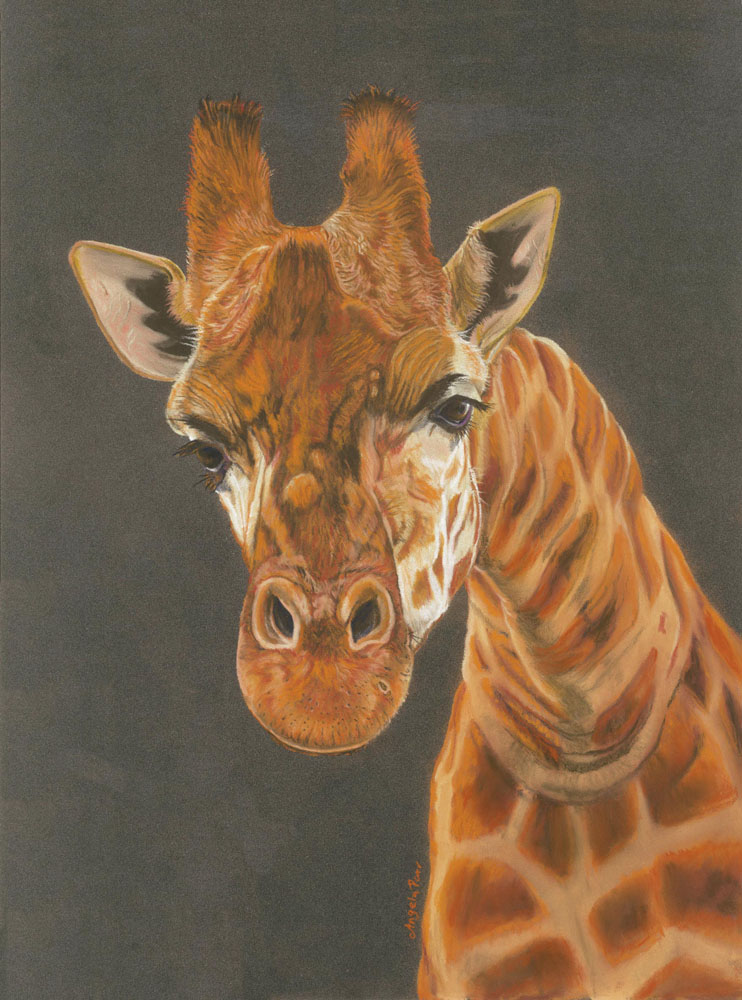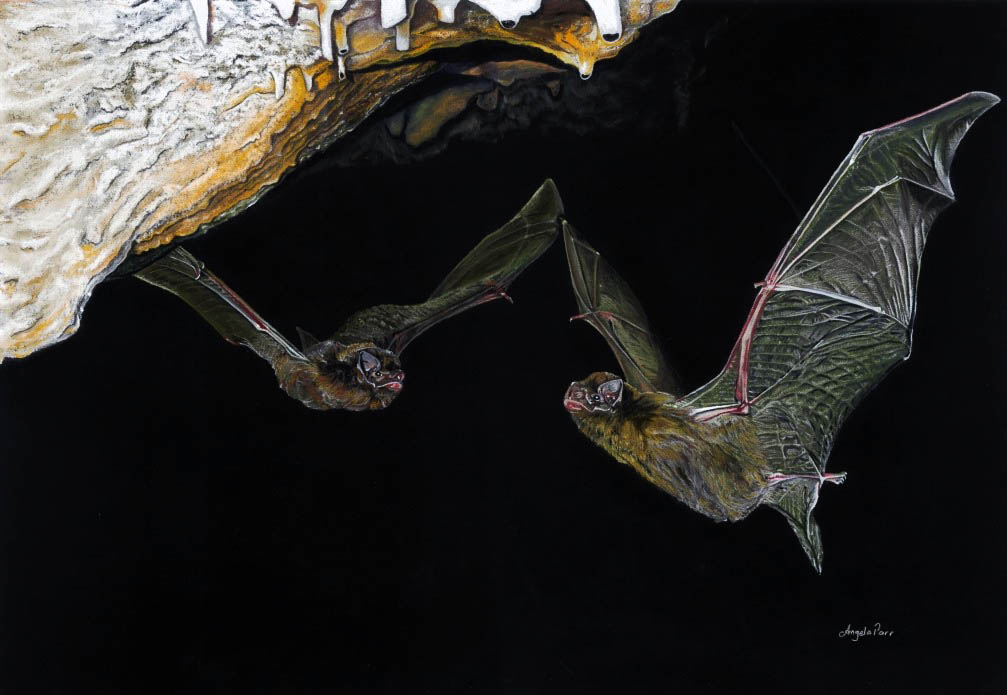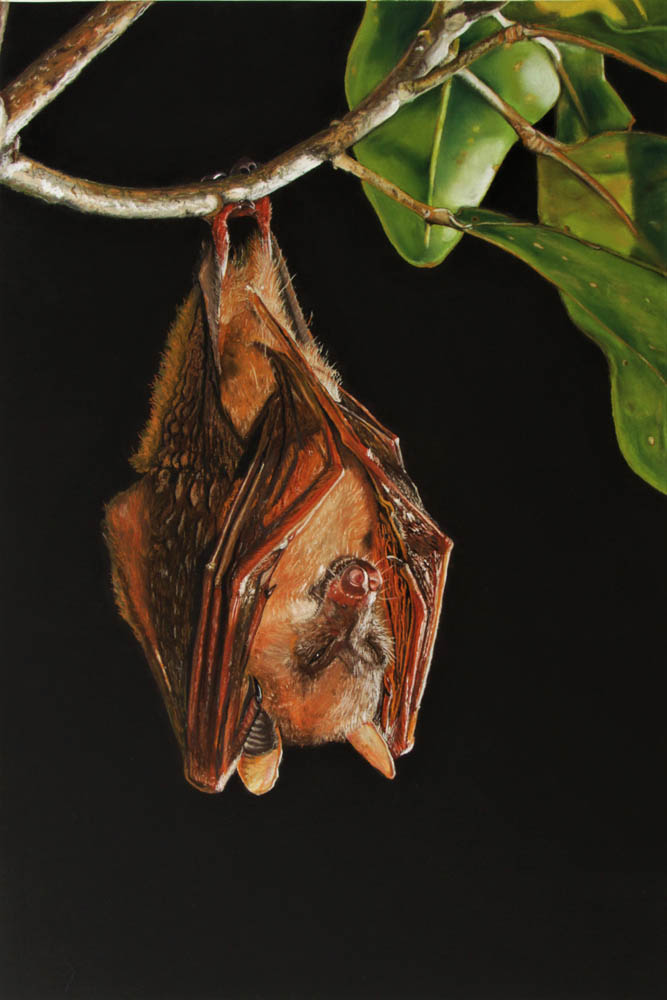Animals
-
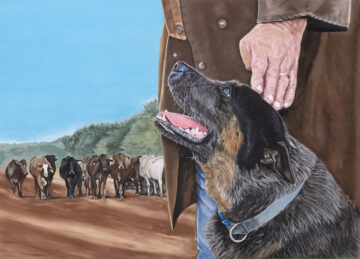
Good Job Girl
Pastel on Pastelmat Card (Sold)
87cm W x 67 cm H
The Australian Cattle Dog (also known as Blue or Red Heelers) was developed for its ability to drive cattle over long distances in the harsh Australian Outback. It is now considered the best breed in the world for this task. It is a sturdy, muscular, compact dog capable of great speed, agility and strength, when required. It will create a strong bond with its owner, typically resulting in the dog never being too far from the owner’s side. The Australian Cattle Dog can be the friendliest of companions, although as it is quick to respond to the emotions of its owners, it will typically be very protective of them and may defend them without waiting for a command. All these combinations make it an excellent farm dog, working when required and caring for the children, keeping them safe from snakes and other “intruders”. In this image, the quintessential Aussie farmer is not gushy with his dog, just a gentle touch on her head tells her she has done a “good Job”.
Read moreGood Job Girl
Pastel on Pastelmat Card (Sold)
87cm W x 67 cm H
The Australian Cattle Dog (also known as Blue or Red Heelers) was developed for its ability to drive cattle over long distances in the harsh Australian Outback. It is now considered the best breed in the world for this task. It is a sturdy, muscular, compact dog capable of great speed, agility and strength, when required. It will create a strong bond with its owner, typically resulting in the dog never being too far from the owner’s side. The Australian Cattle Dog can be the friendliest of companions, although as it is quick to respond to the emotions of its owners, it will typically be very protective of them and may defend them without waiting for a command. All these combinations make it an excellent farm dog, working when required and caring for the children, keeping them safe from snakes and other “intruders”. In this image, the quintessential Aussie farmer is not gushy with his dog, just a gentle touch on her head tells her she has done a “good Job”.
Quick View -
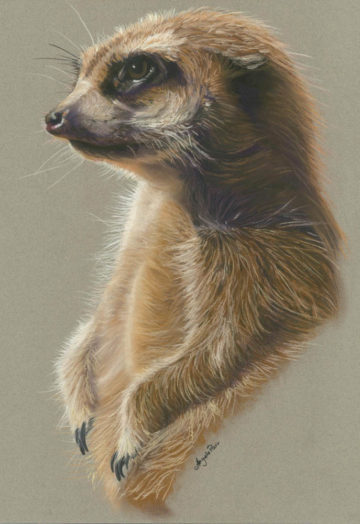
Suricate Sentinel
Pastel on Canson pastel paper (Sold)
32cm W x 45cm H
The Meerkat (Suricata suricatta) is a highly intelligent omnivore (standing only about 25 – 30cm from head to rump) found in southern Africa. The dark patches around their eyes help cut down on the sun’s glare, and their thin fur and dark skin on their stomachs assists them to control body temperature. Their diet consists of insects, lizards, birds, and fruit. When hunting small game, they work together and communicate with purring sounds. As they forage for insects and other prey, they bury their heads in the sand, so they need a reliable and trusted sentry to be on the alert for predatory snakes, hawks, eagles and jackals. This curious upright stance keeps the rest of the gang safe.Read moreSuricate Sentinel
Pastel on Canson pastel paper (Sold)
32cm W x 45cm H
The Meerkat (Suricata suricatta) is a highly intelligent omnivore (standing only about 25 – 30cm from head to rump) found in southern Africa. The dark patches around their eyes help cut down on the sun’s glare, and their thin fur and dark skin on their stomachs assists them to control body temperature. Their diet consists of insects, lizards, birds, and fruit. When hunting small game, they work together and communicate with purring sounds. As they forage for insects and other prey, they bury their heads in the sand, so they need a reliable and trusted sentry to be on the alert for predatory snakes, hawks, eagles and jackals. This curious upright stance keeps the rest of the gang safe.Quick View -
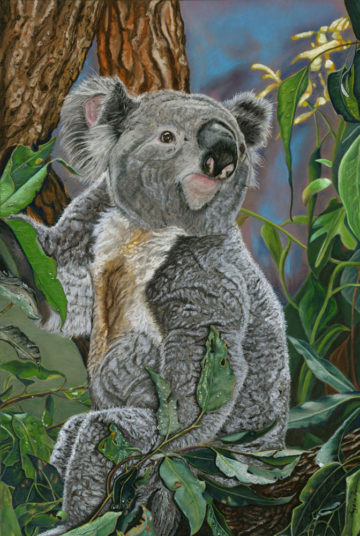
A Comfortable Seat
Pastel on Colour Fix Art Spectrum paper ($POA)
39 cm W x 58 cm H
The Koala (Phascolarctos cinereus) is an arboreal herbivorous marsupial, and an integral part of the Australian bush. They usually sleep for 20 hours a day, perched high up in eucalyptus trees. Their diet consists exclusively of these leaves, considered poisonous to most other animals. The word ‘Koala’ is thought to mean ‘no drink’ in the Australian Aboriginal language, however koalas do drink especially during heatwaves and in times of drought. Koalas are in serious danger of becoming extinct by 2050 due to deforestation, drought and bushfires.
This little guy is “Arni”, a northern koala (their fur is shorter and more silvery-grey than their southern cousins). He is a lovely gentle male, almost in his prime, who happily resides at the Byron Bay Wildlife Sanctuary, in northern NSW.Read moreA Comfortable Seat
Pastel on Colour Fix Art Spectrum paper ($POA)
39 cm W x 58 cm H
The Koala (Phascolarctos cinereus) is an arboreal herbivorous marsupial, and an integral part of the Australian bush. They usually sleep for 20 hours a day, perched high up in eucalyptus trees. Their diet consists exclusively of these leaves, considered poisonous to most other animals. The word ‘Koala’ is thought to mean ‘no drink’ in the Australian Aboriginal language, however koalas do drink especially during heatwaves and in times of drought. Koalas are in serious danger of becoming extinct by 2050 due to deforestation, drought and bushfires.
This little guy is “Arni”, a northern koala (their fur is shorter and more silvery-grey than their southern cousins). He is a lovely gentle male, almost in his prime, who happily resides at the Byron Bay Wildlife Sanctuary, in northern NSW.Quick View -
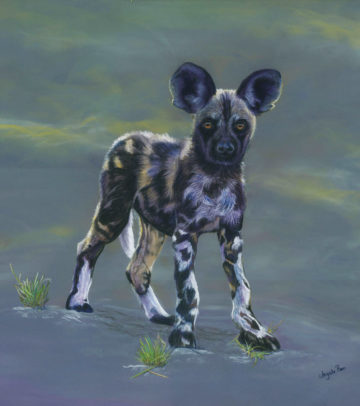
African Wild Dog Pup
Pastel on Pastelmat paper (Sold)
67 cm W x 61 cm H
The African Wild Dog (Lycaon pictus), also known as the Painted Dog, is a very clever carnivore with amazingly complex social hierarchies and extraordinary communication habits. They exhibit elaborate greeting rituals, care for injured pack mates, and have their own sneeze-based form of democracy. They are named for their mottled fur which is like paint splashed on a canvas, and each animal displays its own entirely unique pattern. Sadly, they are the second most endangered carnivore in all of Africa, with fewer than 1,400 mature adults in the wild. Human encroachment and diseases from domestic dogs are their greatest threats.
This little pup in Kenya, was nervously waiting for its mother to return from the hunt.Read moreAfrican Wild Dog Pup
Pastel on Pastelmat paper (Sold)
67 cm W x 61 cm H
The African Wild Dog (Lycaon pictus), also known as the Painted Dog, is a very clever carnivore with amazingly complex social hierarchies and extraordinary communication habits. They exhibit elaborate greeting rituals, care for injured pack mates, and have their own sneeze-based form of democracy. They are named for their mottled fur which is like paint splashed on a canvas, and each animal displays its own entirely unique pattern. Sadly, they are the second most endangered carnivore in all of Africa, with fewer than 1,400 mature adults in the wild. Human encroachment and diseases from domestic dogs are their greatest threats.
This little pup in Kenya, was nervously waiting for its mother to return from the hunt.Quick View -
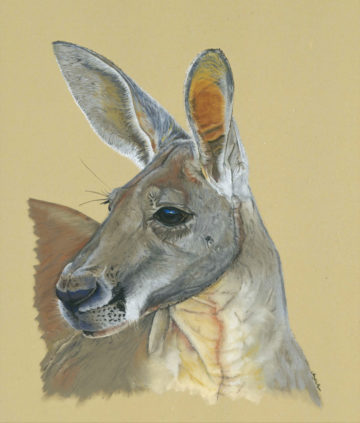
Andrew
Pastel on Pastelmat paper (Sold)
67 cm W x 88 cm H
Andrew is a big Red Kangaroo, (Macropus rufus) one of the many offspring of the famous alpha-male Red Kangaroo “Roger”, raised in the Kangaroo Sanctuary in Alice Springs. The Red Kangaroo is the largest of all kangaroos, which are terrestrial marsupials native to Australia, and they are found over most of the arid parts of the country, preferring flat open plains. Big Reds may weigh as much as 90kg and reach 1.8 meters in height when standing. When male kangaroos fight over potential mates, they appear to be boxing. They balance on their strong tails, grab their rival with their forearms and kick with their powerful hind legs. They attempt to push their opponent off balance. Kangaroos can also bite and wield sharp claws, which they may do in battle with an enemy like a dingo.Read moreAndrew
Pastel on Pastelmat paper (Sold)
67 cm W x 88 cm H
Andrew is a big Red Kangaroo, (Macropus rufus) one of the many offspring of the famous alpha-male Red Kangaroo “Roger”, raised in the Kangaroo Sanctuary in Alice Springs. The Red Kangaroo is the largest of all kangaroos, which are terrestrial marsupials native to Australia, and they are found over most of the arid parts of the country, preferring flat open plains. Big Reds may weigh as much as 90kg and reach 1.8 meters in height when standing. When male kangaroos fight over potential mates, they appear to be boxing. They balance on their strong tails, grab their rival with their forearms and kick with their powerful hind legs. They attempt to push their opponent off balance. Kangaroos can also bite and wield sharp claws, which they may do in battle with an enemy like a dingo.Quick View -
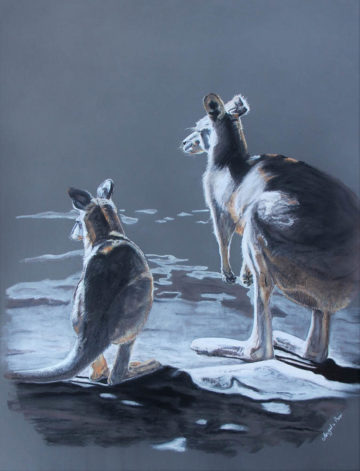
Morning Light
Pastel on Canson paper ($POA)
71 cm W x 91 cm H
The Eastern Grey Kangaroo, (Macropus giganteus), is one of 73 species of macropods. (The Greek words makros meaning large and poús or pod meaning foot) The key distinguishing features of all macropods are their triangular body shapes, large hind legs and feet, and disproportionately small front limbs. All have forward-facing pouches, and most use hopping as their primary mode of locomotion. The Eastern Grey is found in the eastern third of Australia, with a population of several million. They live in groups called Mobs and are highly sociable. Joeys usually stay in the pouch for 11 months and then continue to feed from their mother for an additional 9 months. This doe and joey were basking in the morning sunlight at Currumbin Wildlife Sanctuary.Read moreMorning Light
Pastel on Canson paper ($POA)
71 cm W x 91 cm H
The Eastern Grey Kangaroo, (Macropus giganteus), is one of 73 species of macropods. (The Greek words makros meaning large and poús or pod meaning foot) The key distinguishing features of all macropods are their triangular body shapes, large hind legs and feet, and disproportionately small front limbs. All have forward-facing pouches, and most use hopping as their primary mode of locomotion. The Eastern Grey is found in the eastern third of Australia, with a population of several million. They live in groups called Mobs and are highly sociable. Joeys usually stay in the pouch for 11 months and then continue to feed from their mother for an additional 9 months. This doe and joey were basking in the morning sunlight at Currumbin Wildlife Sanctuary.Quick View -
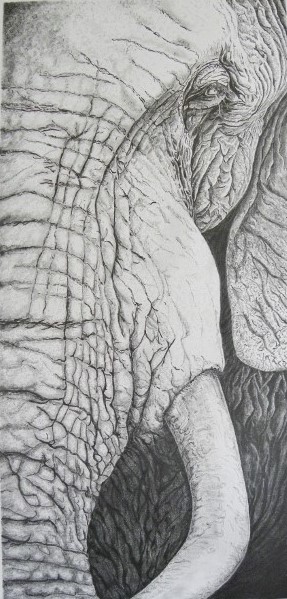
I am Elephant
Graphite on Arches paper ($POA)
42 cm W x 63 cm H
The African Bush Elephant (Loxodonta africana) is considered endangered, threatened by habitat loss and fragmentation, and poaching for the illegal ivory trade. African elephants have grey folded skin up to 30 mm thick that is covered with sparse, bristled dark brown to black hair. The trunk is a prehensile elongation of its upper lip and nose, manipulated by about 40,000–60,000 muscles and so strong that elephants can use it for lifting about 3% of their own body weight. They use it for smelling, touching, feeding, drinking, dusting, producing sounds, loading, defending and attacking. This artwork focuses on the skin, trunk and tusk of a large bull and attempts to convey the immense size and strength of these magnificent creatures.Read moreI am Elephant
Graphite on Arches paper ($POA)
42 cm W x 63 cm H
The African Bush Elephant (Loxodonta africana) is considered endangered, threatened by habitat loss and fragmentation, and poaching for the illegal ivory trade. African elephants have grey folded skin up to 30 mm thick that is covered with sparse, bristled dark brown to black hair. The trunk is a prehensile elongation of its upper lip and nose, manipulated by about 40,000–60,000 muscles and so strong that elephants can use it for lifting about 3% of their own body weight. They use it for smelling, touching, feeding, drinking, dusting, producing sounds, loading, defending and attacking. This artwork focuses on the skin, trunk and tusk of a large bull and attempts to convey the immense size and strength of these magnificent creatures.Quick View -
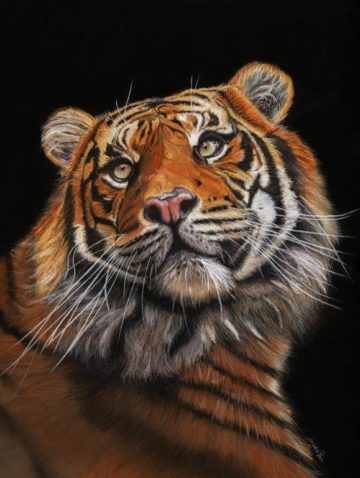
Just a Big Pussycat
Pastel on Colour Fix Art Spectrum paper ($POA)
44 cm W x 58 cm H
The Indian Tiger (Panthera tigris) is surely the most stunning of the big cats, with its distinctive dark vertical stripes on orange fur with a white underside. It is an apex predator, primarily preying on ungulates such as deer and wild boar. It is territorial and generally solitary. It is listed as endangered on the IUCN Red List. As of 2024, the global wild tiger population was estimated to number of 5,574 mature individuals, with most living in small, isolated pockets. Major reasons for population decline are habitat destruction, habitat fragmentation, human-wildlife conflict and poaching.
source World Animal FoundationRead moreJust a Big Pussycat
Pastel on Colour Fix Art Spectrum paper ($POA)
44 cm W x 58 cm H
The Indian Tiger (Panthera tigris) is surely the most stunning of the big cats, with its distinctive dark vertical stripes on orange fur with a white underside. It is an apex predator, primarily preying on ungulates such as deer and wild boar. It is territorial and generally solitary. It is listed as endangered on the IUCN Red List. As of 2024, the global wild tiger population was estimated to number of 5,574 mature individuals, with most living in small, isolated pockets. Major reasons for population decline are habitat destruction, habitat fragmentation, human-wildlife conflict and poaching.
source World Animal FoundationQuick View -
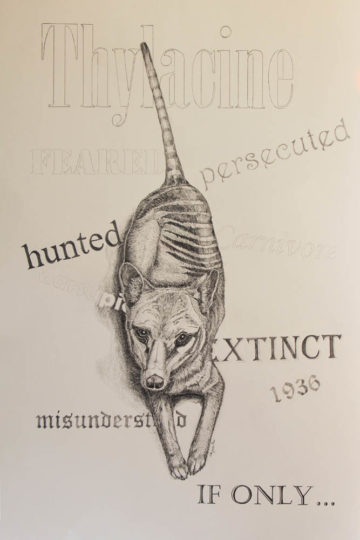
If Only… (Thylacine)
Graphite on Cotton Rag paper (Sold)
53 cm W x 75 cm H
The Tasmanian Tiger (Thylacinus cynocephalus) meaning dog-headed pouched-dog, was a large carnivorous marsupial now believed to be extinct. Once roaming all of mainland Australia it is estimated there were around 5000 thylacines in Tasmania at the time of European settlement. Shamefully, whilst its decline and extinction was hastened by habitat destruction and introduced diseases from dogs, largely its demise was due to human persecution and hunting as an alleged pest. Sadly, the last known thylacine died from exposure at a Zoo in Hobart on 7 September 1936 only two months after the species was granted protected status.
Not having a live specimen to draw from, I taped “stripes” to my cattle dog and used her as the basis for this artwork, refining the details as I worked.Read moreIf Only… (Thylacine)
Graphite on Cotton Rag paper (Sold)
53 cm W x 75 cm H
The Tasmanian Tiger (Thylacinus cynocephalus) meaning dog-headed pouched-dog, was a large carnivorous marsupial now believed to be extinct. Once roaming all of mainland Australia it is estimated there were around 5000 thylacines in Tasmania at the time of European settlement. Shamefully, whilst its decline and extinction was hastened by habitat destruction and introduced diseases from dogs, largely its demise was due to human persecution and hunting as an alleged pest. Sadly, the last known thylacine died from exposure at a Zoo in Hobart on 7 September 1936 only two months after the species was granted protected status.
Not having a live specimen to draw from, I taped “stripes” to my cattle dog and used her as the basis for this artwork, refining the details as I worked.Quick View -
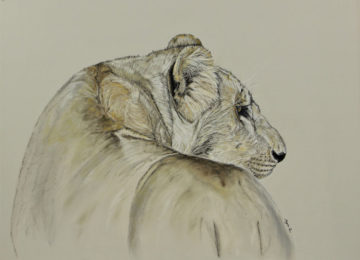
The Huntress
Pastel on Pastelmat Board ($POA)
(size to come)
Lions (Panthera leo) are unique among cats in that they live in a pride, often consisting of about 15 individuals. Lionesses are the chief hunters. They prey on animals of all sizes, including hippopotamuses, but prefer wildebeests, antelopes, and zebras. Lionesses are much faster than their male counterparts because of their sleeker and lighter bodies. A Lion runs at 35 mph however a Lioness can reach up to a speed of 45 mph.
This beautiful female in Tanzania was testing the breeze for possible prey in the vicinity.Read moreThe Huntress
Pastel on Pastelmat Board ($POA)
(size to come)
Lions (Panthera leo) are unique among cats in that they live in a pride, often consisting of about 15 individuals. Lionesses are the chief hunters. They prey on animals of all sizes, including hippopotamuses, but prefer wildebeests, antelopes, and zebras. Lionesses are much faster than their male counterparts because of their sleeker and lighter bodies. A Lion runs at 35 mph however a Lioness can reach up to a speed of 45 mph.
This beautiful female in Tanzania was testing the breeze for possible prey in the vicinity.Quick View -
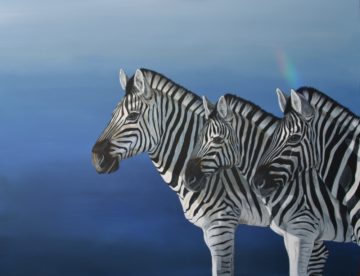
Watching the Lions
Acrylic on Canvas (Sold)
102 cm W x 76 cm H
Plains Zebras (Equus quagga) are the most common of the three zebra species and found in much of southern and eastern Africa south of the Sahara. Zebras have black skin with white stripes which help keep them cool. The stripes are thought to disperse more than 70% of incoming heat, preventing them from overheating in the sweltering African sun. Air moves at different speeds over light-absorbing black stripes and light-reflecting white stripes, so the animal creates its own cooling air currents. These three were standing around a waterhole in Namibia watching a young lion practise her hunting techniques, highly alert for a quick getaway if required.Read moreWatching the Lions
Acrylic on Canvas (Sold)
102 cm W x 76 cm H
Plains Zebras (Equus quagga) are the most common of the three zebra species and found in much of southern and eastern Africa south of the Sahara. Zebras have black skin with white stripes which help keep them cool. The stripes are thought to disperse more than 70% of incoming heat, preventing them from overheating in the sweltering African sun. Air moves at different speeds over light-absorbing black stripes and light-reflecting white stripes, so the animal creates its own cooling air currents. These three were standing around a waterhole in Namibia watching a young lion practise her hunting techniques, highly alert for a quick getaway if required.Quick View -
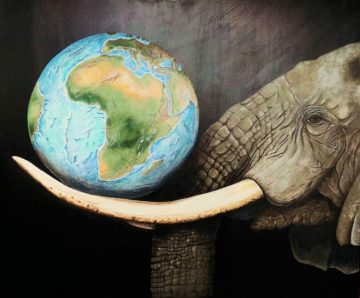
Only an Elephant Needs Ivory
Acrylic on Canvas (Sold)
102 cm W x 76 cm H
Elephant tusks are primarily used to dig for roots and strip the bark from trees for food, for fighting each other during mating season, and for defending themselves against predators. The tusks weigh from 23 to 45 kg and can be from 1.5 to 2.4 m long. Tusks have no intrinsic value, but ivory has been a status symbol for millennia in Africa because it comes from elephants, a highly respected animal, and because it is easy to carve into works of art. An African poacher can get $80 for a kilogram of ivory which is a lot of money in most African countries. But the big profit is made in Asia. Thai Customs recently evaluated smuggled ivory as being worth $1,800 per kilogram wholesale. And of course it is almost impossible to remove tusks from wild elephants without having to kill them first. My artwork draws attention to this shameful trade.Read moreOnly an Elephant Needs Ivory
Acrylic on Canvas (Sold)
102 cm W x 76 cm H
Elephant tusks are primarily used to dig for roots and strip the bark from trees for food, for fighting each other during mating season, and for defending themselves against predators. The tusks weigh from 23 to 45 kg and can be from 1.5 to 2.4 m long. Tusks have no intrinsic value, but ivory has been a status symbol for millennia in Africa because it comes from elephants, a highly respected animal, and because it is easy to carve into works of art. An African poacher can get $80 for a kilogram of ivory which is a lot of money in most African countries. But the big profit is made in Asia. Thai Customs recently evaluated smuggled ivory as being worth $1,800 per kilogram wholesale. And of course it is almost impossible to remove tusks from wild elephants without having to kill them first. My artwork draws attention to this shameful trade.Quick View -
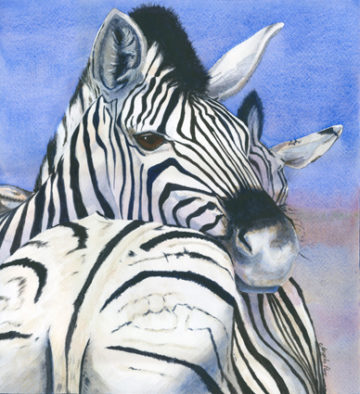
The Rear Guard
Watercolour on Arches paper ($POA)
30 cm W x 33 cm H
Being the favourite prey of lions, zebras must always be alert, and often stand head to tail to keep an eye on the terrain all around them. Naturally when they stand this way, they can also give each other a good scratch on the rump, and with their tails constantly swishing, help chase flies away from each other’s faces.Read moreThe Rear Guard
Watercolour on Arches paper ($POA)
30 cm W x 33 cm H
Being the favourite prey of lions, zebras must always be alert, and often stand head to tail to keep an eye on the terrain all around them. Naturally when they stand this way, they can also give each other a good scratch on the rump, and with their tails constantly swishing, help chase flies away from each other’s faces.Quick View -
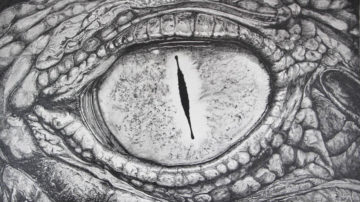
Watching and Waiting 1
Graphite on Arches paper (Sold)
45 cm W x 33 cm H
Earth’s largest living crocodilian—and, some say, the animal most likely to eat a human—is the saltwater or estuarine crocodile, (Crocodylus porosus). The typical male Saltwater Crocodile has an overall length of 4.25-7 m, with females at lengths of 2.30-3.35 m. An average male Saltwater Crocodile weighs between 400-1000 kg and has a typical lifespan of 70-100 years in the wild.
I have equal parts fascination and fear of these ancient reptiles but managed to convince myself to swim for 15 minutes in the famous “Cage of Death”, at Crocosaurus Cove in Darwin and eyeball a 5-metre monster through the acrylic-strengthened “glass” cage.Read moreWatching and Waiting 1
Graphite on Arches paper (Sold)
45 cm W x 33 cm H
Earth’s largest living crocodilian—and, some say, the animal most likely to eat a human—is the saltwater or estuarine crocodile, (Crocodylus porosus). The typical male Saltwater Crocodile has an overall length of 4.25-7 m, with females at lengths of 2.30-3.35 m. An average male Saltwater Crocodile weighs between 400-1000 kg and has a typical lifespan of 70-100 years in the wild.
I have equal parts fascination and fear of these ancient reptiles but managed to convince myself to swim for 15 minutes in the famous “Cage of Death”, at Crocosaurus Cove in Darwin and eyeball a 5-metre monster through the acrylic-strengthened “glass” cage.Quick View -
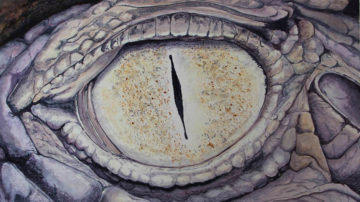
Watching and Waiting 2
Watercolour on Arches paper (Sold)
45 cm W x 33 cm H
Saltwater crocodiles were hunted close to extinction before they were declared a protected species in the 1970s. It’s estimated as few as 3000 were left in the Northern Territory when hunting was bad – but in the decades since, numbers have boomed. Exact populations are unknown, but it’s estimated the NT waterways are now home to about 100,000 “salties”, and Queensland 30,000. As the increase in numbers eases off, the size of the creatures increases, with males capable of reaching 6 metres.
This artwork is a repeat of the previous one but completed in watercolours. It’s interesting how this gives a different feel to the same subject.Read moreWatching and Waiting 2
Watercolour on Arches paper (Sold)
45 cm W x 33 cm H
Saltwater crocodiles were hunted close to extinction before they were declared a protected species in the 1970s. It’s estimated as few as 3000 were left in the Northern Territory when hunting was bad – but in the decades since, numbers have boomed. Exact populations are unknown, but it’s estimated the NT waterways are now home to about 100,000 “salties”, and Queensland 30,000. As the increase in numbers eases off, the size of the creatures increases, with males capable of reaching 6 metres.
This artwork is a repeat of the previous one but completed in watercolours. It’s interesting how this gives a different feel to the same subject.Quick View -
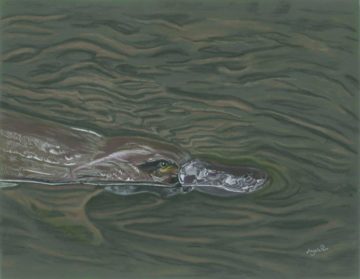
Platypus Oma
Pastel on Mi Tientes Tex ($POA)
49 cm W x 42 cm H
During February 2019 tropical cyclone Oma caused gale force winds, abnormally high tides and large surf about the southeast Queensland coast, northern New South Wales coast and Lord Howe Island. During this period a platypus (Ornithorhynchus anatinus) found its way into our small creek and pond, displaying little fear of us as it hunted for freshwater yabbies. Naturally it became known as Platypus Oma and had to be immortalised in art. The IUCN lists the platypus on its Red List as “Near Threatened” as assessed in 2016, when it was estimated that numbers had reduced by about 30 percent on average since European settlement. Since Platypus Oma we have spotted another two platypi in our creek at different times and are always thrilled to do so.Read morePlatypus Oma
Pastel on Mi Tientes Tex ($POA)
49 cm W x 42 cm H
During February 2019 tropical cyclone Oma caused gale force winds, abnormally high tides and large surf about the southeast Queensland coast, northern New South Wales coast and Lord Howe Island. During this period a platypus (Ornithorhynchus anatinus) found its way into our small creek and pond, displaying little fear of us as it hunted for freshwater yabbies. Naturally it became known as Platypus Oma and had to be immortalised in art. The IUCN lists the platypus on its Red List as “Near Threatened” as assessed in 2016, when it was estimated that numbers had reduced by about 30 percent on average since European settlement. Since Platypus Oma we have spotted another two platypi in our creek at different times and are always thrilled to do so.Quick View -
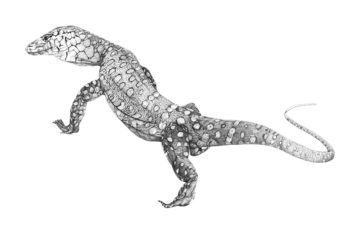
Perentie
Ink on Arches paper (Sold)
90 cm W x 65 cm H
The perentie (Varanus giganteus) is the largest monitor lizard or goanna native to Australia. It is the fourth-largest living lizard on earth, after the Komodo dragon, Asian water monitor, and the crocodile monitor. Found west of the Great Dividing Range in the arid areas of Australia, it is rarely seen, because of its shyness and the remoteness of much of its range from human habitation. They can grow up to 2.5 m long, (although the typical length is around 1.7 to 2.0 m) and weigh up to 15 kg. This healthy specimen scarpered over the road in front of us near Arltunga in the Northern Territory and I managed a quick photo before it disappeared into the scrub.Read morePerentie
Ink on Arches paper (Sold)
90 cm W x 65 cm H
The perentie (Varanus giganteus) is the largest monitor lizard or goanna native to Australia. It is the fourth-largest living lizard on earth, after the Komodo dragon, Asian water monitor, and the crocodile monitor. Found west of the Great Dividing Range in the arid areas of Australia, it is rarely seen, because of its shyness and the remoteness of much of its range from human habitation. They can grow up to 2.5 m long, (although the typical length is around 1.7 to 2.0 m) and weigh up to 15 kg. This healthy specimen scarpered over the road in front of us near Arltunga in the Northern Territory and I managed a quick photo before it disappeared into the scrub.Quick View -
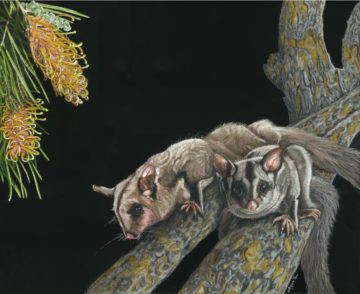
Scamper and Scurry
Pastel on Mi Tientes Tex (Sold)
53 cm W x 43 cm H
The models for this artwork are Samson and Sebastian, four-year-old brothers and the resident Sugar gliders of Byron Bay Wildlife Sanctuary (formerly Macadamia Castle). The sugar glider (Petaurus breviceps) is a small, omnivorous, arboreal, and nocturnal gliding possum belonging to the marsupial infraclass. The common name refers to its predilection for sugary foods such as sap and nectar (hence the inclusion of the grevillea in the artwork) and its ability to glide through the air, much like a flying squirrel. Its pair of gliding membranes, known as patagia, extend from its forelegs to its hindlegs enabling it to glide 50 metres or more. Gliding serves as an efficient means of reaching food and evading predators.Read moreScamper and Scurry
Pastel on Mi Tientes Tex (Sold)
53 cm W x 43 cm H
The models for this artwork are Samson and Sebastian, four-year-old brothers and the resident Sugar gliders of Byron Bay Wildlife Sanctuary (formerly Macadamia Castle). The sugar glider (Petaurus breviceps) is a small, omnivorous, arboreal, and nocturnal gliding possum belonging to the marsupial infraclass. The common name refers to its predilection for sugary foods such as sap and nectar (hence the inclusion of the grevillea in the artwork) and its ability to glide through the air, much like a flying squirrel. Its pair of gliding membranes, known as patagia, extend from its forelegs to its hindlegs enabling it to glide 50 metres or more. Gliding serves as an efficient means of reaching food and evading predators.Quick View -
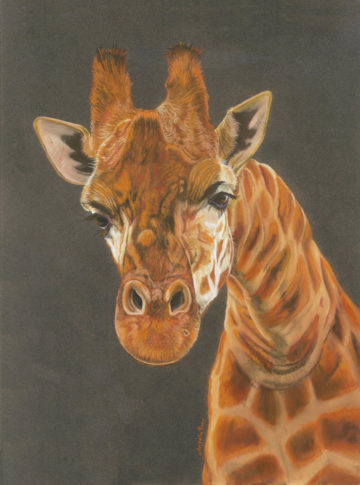
Well Hello There
Pastel on Pastelmat paper ($POA)
45 cm W x 55 cm H
On a lovely morning at Taronga Western Plains Zoo, Dubbo, NSW, we were fortunate to have a private tour of the Savannah where many African animals roam freely. A curious male giraffe poked his long neck (and head) into our jeep searching for treats. Both male and female giraffes have horns, but the tops of the horns on a male are almost always bald, whilst the female’s horns will be completely covered with hair. As females don’t fight, they never lose the hair on their horns.
The Giraffe is the tallest of all animals, with males sometimes growing up to 5.5 metres in height and weighing over 1000 kg! The northern giraffe (Giraffa camelopardalis), also known as the three-horned giraffe, is the species of giraffe native to North Africa. Once abundant throughout Africa since the 19th century, it is now isolated in South Sudan, Kenya, Chad and Niger. All giraffes are considered ‘Vulnerable to Extinction’ by the IUCN. There are currently only 5,195 northern giraffes in the wild.Read moreWell Hello There
Pastel on Pastelmat paper ($POA)
45 cm W x 55 cm H
On a lovely morning at Taronga Western Plains Zoo, Dubbo, NSW, we were fortunate to have a private tour of the Savannah where many African animals roam freely. A curious male giraffe poked his long neck (and head) into our jeep searching for treats. Both male and female giraffes have horns, but the tops of the horns on a male are almost always bald, whilst the female’s horns will be completely covered with hair. As females don’t fight, they never lose the hair on their horns.
The Giraffe is the tallest of all animals, with males sometimes growing up to 5.5 metres in height and weighing over 1000 kg! The northern giraffe (Giraffa camelopardalis), also known as the three-horned giraffe, is the species of giraffe native to North Africa. Once abundant throughout Africa since the 19th century, it is now isolated in South Sudan, Kenya, Chad and Niger. All giraffes are considered ‘Vulnerable to Extinction’ by the IUCN. There are currently only 5,195 northern giraffes in the wild.Quick View -
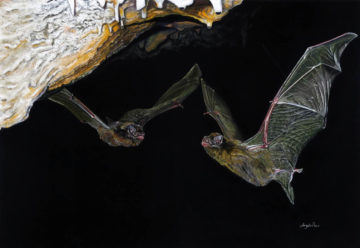
Common Bentwing Bats on the Wing
Pastel on Canson paper ($POA)
63 cm W x 48 cm H
A brilliant fellow artist Andy Reimanis invited me to participate in a joint exhibition of local micro things, in the gallery at Murwillumbah on the banks of the Tweed River. I would represent microbats and he would represent microflora. What followed couldn’t have been scripted… Heavy rainfall in the wake of ex Cyclone Debbie in March 2017 caused major flooding in the states of Queensland and New South Wales. Mullumbimby recorded over 300 mm of rain in 24 hours and the Tweed River reached levels not seen for over 40 years. Authorities ordered over 20,000 people to evacuate their homes. The gallery was completely devastated. Our exhibition never materialised but the artwork had been completed thanks to the generous provision of reference material from Bruce Thomson of QNPWS and Terry Reardon from the South Australian Museum. This piece was one of those created during this time.Read moreCommon Bentwing Bats on the Wing
Pastel on Canson paper ($POA)
63 cm W x 48 cm H
A brilliant fellow artist Andy Reimanis invited me to participate in a joint exhibition of local micro things, in the gallery at Murwillumbah on the banks of the Tweed River. I would represent microbats and he would represent microflora. What followed couldn’t have been scripted… Heavy rainfall in the wake of ex Cyclone Debbie in March 2017 caused major flooding in the states of Queensland and New South Wales. Mullumbimby recorded over 300 mm of rain in 24 hours and the Tweed River reached levels not seen for over 40 years. Authorities ordered over 20,000 people to evacuate their homes. The gallery was completely devastated. Our exhibition never materialised but the artwork had been completed thanks to the generous provision of reference material from Bruce Thomson of QNPWS and Terry Reardon from the South Australian Museum. This piece was one of those created during this time.Quick View -
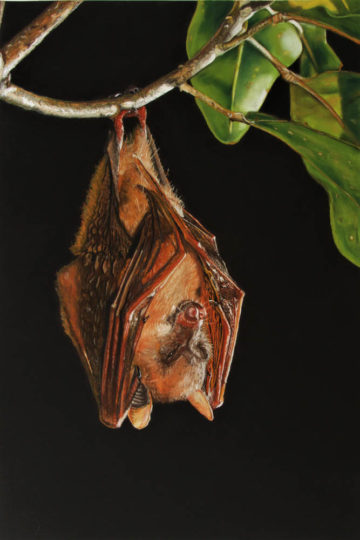
Eastern Blossom Bat
Pastel on Canson paper (SOLD)
46 cm W x 62 cm H
Another in my microbat series although technically Blossom Bats are a bit larger in size than true microbats. Also known as the Common Blossom Bat or the Southern Blossom Bat, the Eastern Blossom Bat (Syconycteris australis) is a small nectar feeding bat. Habitat includes rainforests, wet eucalypt forests and paperbark swamps throughout eastern and north-eastern Australia. It is fawn to reddish-brown in colour above with a paler belly. It has a long narrow (I think very cute) face, large eyes and a very long thin tongue, with a brush-like tip. Its diet is highly specialised, consisting of nectar and pollen from bottlebrush, paperbark, banksia and gum tree blossoms. It is an important pollinator of many rainforest plants.Read moreEastern Blossom Bat
Pastel on Canson paper (SOLD)
46 cm W x 62 cm H
Another in my microbat series although technically Blossom Bats are a bit larger in size than true microbats. Also known as the Common Blossom Bat or the Southern Blossom Bat, the Eastern Blossom Bat (Syconycteris australis) is a small nectar feeding bat. Habitat includes rainforests, wet eucalypt forests and paperbark swamps throughout eastern and north-eastern Australia. It is fawn to reddish-brown in colour above with a paler belly. It has a long narrow (I think very cute) face, large eyes and a very long thin tongue, with a brush-like tip. Its diet is highly specialised, consisting of nectar and pollen from bottlebrush, paperbark, banksia and gum tree blossoms. It is an important pollinator of many rainforest plants.Quick View -
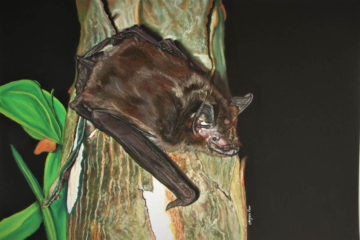
Eastern Falsistrelle
Pastel on Canson paper (Sold)
63 cm W x 48 cm H
Very little is known about Eastern False Pipistrelles or Falsistrelles (Falsistrellus tasmaniensis). They feed on insects, including moths, beetles and ants. Like all microbats they are a wonderfully natural method of pest control as they devour lawn grub moths, weevils, caterpillars, beetles, midges, flying termites, mosquitoes and other insects. Microbats can eat as much as 40% of their own body weight in a single night or several hundred insects per hour. Sadly they are under threat from intensive forestry activity in their habitat, cleared for agriculture and housing, as they roost in hollows in old trees in higher rainfall forests. They do however occasionally roost in disused buildings.Read moreEastern Falsistrelle
Pastel on Canson paper (Sold)
63 cm W x 48 cm H
Very little is known about Eastern False Pipistrelles or Falsistrelles (Falsistrellus tasmaniensis). They feed on insects, including moths, beetles and ants. Like all microbats they are a wonderfully natural method of pest control as they devour lawn grub moths, weevils, caterpillars, beetles, midges, flying termites, mosquitoes and other insects. Microbats can eat as much as 40% of their own body weight in a single night or several hundred insects per hour. Sadly they are under threat from intensive forestry activity in their habitat, cleared for agriculture and housing, as they roost in hollows in old trees in higher rainfall forests. They do however occasionally roost in disused buildings.Quick View -
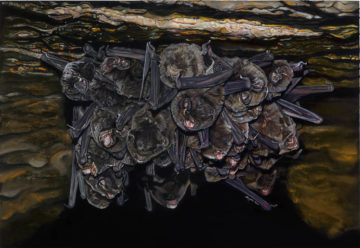
Little Bentwing Bats Roosting
Pastel on Canson paper (Sold)
63 cm W x 48 cm H
Little Bent-wing Bats (Miniopterus australis) roost in caves, mine tunnels and tree hollows, often in colonies numbering in the hundreds. Common Bent-wing Bats are often found roosting alongside them. Like all microbats, Little Bent-wing Bats also feed on small insects that fly beneath the canopy of thick forests. They are agile fliers, having to manoeuvre through the trees to catch their prey. Female Little Bent-wing Bats have a single baby in summer. They leave their babies in nursery caves at night to go and hunt, returning in the morning. These bats are also vulnerable to disturbance from human visitors to cave roosts, destruction of caves by limestone mining, and loss of feeding habitat by forestry operations, clearing and land degradation from agriculture.
I enjoyed creating this artwork although I found it challenging controlling the pastel dust fallout on the black paper and counting all those heads, making sure everything aligned correctly.Read moreLittle Bentwing Bats Roosting
Pastel on Canson paper (Sold)
63 cm W x 48 cm H
Little Bent-wing Bats (Miniopterus australis) roost in caves, mine tunnels and tree hollows, often in colonies numbering in the hundreds. Common Bent-wing Bats are often found roosting alongside them. Like all microbats, Little Bent-wing Bats also feed on small insects that fly beneath the canopy of thick forests. They are agile fliers, having to manoeuvre through the trees to catch their prey. Female Little Bent-wing Bats have a single baby in summer. They leave their babies in nursery caves at night to go and hunt, returning in the morning. These bats are also vulnerable to disturbance from human visitors to cave roosts, destruction of caves by limestone mining, and loss of feeding habitat by forestry operations, clearing and land degradation from agriculture.
I enjoyed creating this artwork although I found it challenging controlling the pastel dust fallout on the black paper and counting all those heads, making sure everything aligned correctly.Quick View -
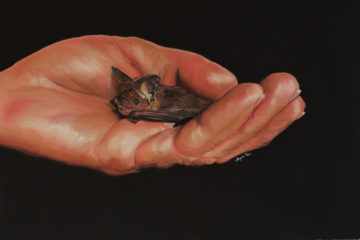
Long Eared Bat Being Held
Pastel on Canson paper ($POA)
63 cm W x 48 cm H
This was the final artwork of the “bat” series, (there were 8 in total), and this is probably my favourite as it clearly shows the diminutive size of microbats. Lesser Long-eared Bats (Nyctophilus geoffroyi) occur in towns and suburbs, roosting in hollows and fissures in old trees, under bark, in old fairy marten (bird) nests and occasionally in caves. They also often roost in ceilings, hollow walls, unused roller doors and canvas awnings in suburban and inner-city areas. Lesser Long-eared Bats hunt near the ground, and swoop around street lights at night catching insects. They are at risk from pesticides and cats. Luckily they prefer hollows of big old eucalypts for nursery colonies.Read moreLong Eared Bat Being Held
Pastel on Canson paper ($POA)
63 cm W x 48 cm H
This was the final artwork of the “bat” series, (there were 8 in total), and this is probably my favourite as it clearly shows the diminutive size of microbats. Lesser Long-eared Bats (Nyctophilus geoffroyi) occur in towns and suburbs, roosting in hollows and fissures in old trees, under bark, in old fairy marten (bird) nests and occasionally in caves. They also often roost in ceilings, hollow walls, unused roller doors and canvas awnings in suburban and inner-city areas. Lesser Long-eared Bats hunt near the ground, and swoop around street lights at night catching insects. They are at risk from pesticides and cats. Luckily they prefer hollows of big old eucalypts for nursery colonies.Quick View -
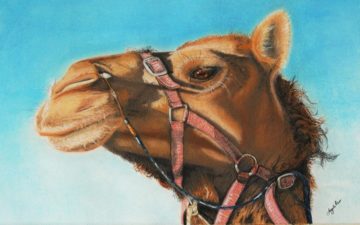
Dixie Doo
Pastel on Canson paper (Sold)
64 cm W x 47 cm H
In 2014 I had the good fortune to join a 3-month camel expedition through the deserts of the Northern Territory and South Australia, with my Red Heeler cattle dog Ruby. The experience was phenomenal, trekking over 20kms daily with eight adult camels, 5 chickens and eventually 5 baby camels…Yes, they were born along the way, but that’s another story. My favourite camel, the one I bonded best with was Dixie, and this artwork is a tribute to her. Between 1870 and 1920, as many as 20,000 camels were imported into Australia from the Arabian Peninsula, India and Afghanistan, together with at least 2,000 handlers, or cameleers, from the same regions. The animals were mainly dromedaries: half-ton ungulates with a single hump, (Camelus dromedarius). They were ideally suited to the harsh, dry climate of the Australian interior: they could go weeks without water, and they had the stamina and strength to carry their loads and riders across what were often highly exposed, fiercely hot landscapes. Laden camels carrying wool and water, telegraph poles and railway sleepers, tea and tobacco became a fixture of outback life. By the 1930s, however, with the arrival of the internal combustion engine, and motorised transport, camels became almost redundant as pack-carriers. A four-legged mammal was no match for a goods vehicle, regardless of how stoic it remained in 40C heat. Thousands of camels were released into the wild, where, naturally, they thrived.Read moreDixie Doo
Pastel on Canson paper (Sold)
64 cm W x 47 cm H
In 2014 I had the good fortune to join a 3-month camel expedition through the deserts of the Northern Territory and South Australia, with my Red Heeler cattle dog Ruby. The experience was phenomenal, trekking over 20kms daily with eight adult camels, 5 chickens and eventually 5 baby camels…Yes, they were born along the way, but that’s another story. My favourite camel, the one I bonded best with was Dixie, and this artwork is a tribute to her. Between 1870 and 1920, as many as 20,000 camels were imported into Australia from the Arabian Peninsula, India and Afghanistan, together with at least 2,000 handlers, or cameleers, from the same regions. The animals were mainly dromedaries: half-ton ungulates with a single hump, (Camelus dromedarius). They were ideally suited to the harsh, dry climate of the Australian interior: they could go weeks without water, and they had the stamina and strength to carry their loads and riders across what were often highly exposed, fiercely hot landscapes. Laden camels carrying wool and water, telegraph poles and railway sleepers, tea and tobacco became a fixture of outback life. By the 1930s, however, with the arrival of the internal combustion engine, and motorised transport, camels became almost redundant as pack-carriers. A four-legged mammal was no match for a goods vehicle, regardless of how stoic it remained in 40C heat. Thousands of camels were released into the wild, where, naturally, they thrived.Quick View -
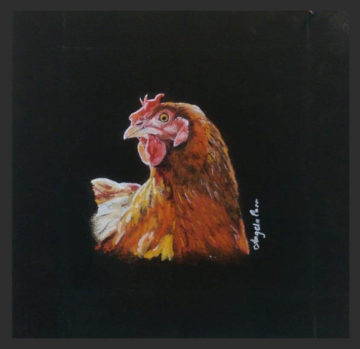
Chicken (Miniature)
Pastel on Canson paper (Sold)
15 cm W x 15 cm H
This small fun piece was done as a donation for a Cancer Council fundraiser.Read moreChicken (Miniature)
Pastel on Canson paper (Sold)
15 cm W x 15 cm H
This small fun piece was done as a donation for a Cancer Council fundraiser.Quick View

